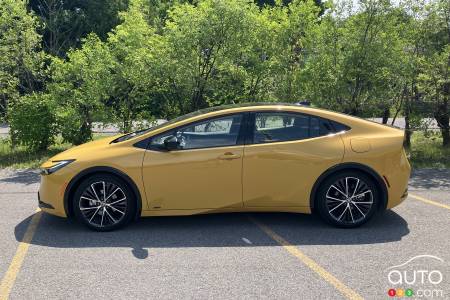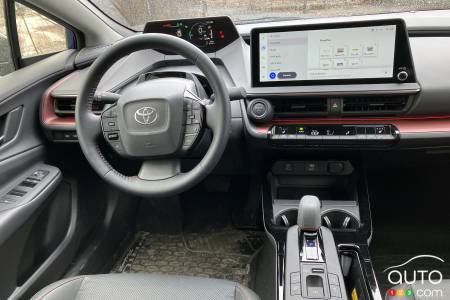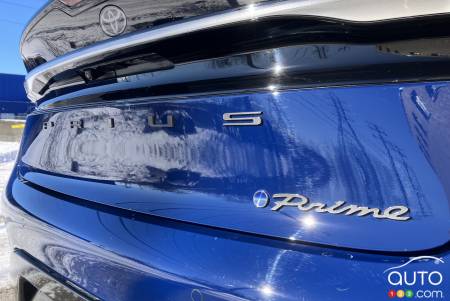Auto123 puts the 2024 Toyota Prius to the in-depth test. Here is the fourth and last chapter of our four-part review.
See: 2024 Toyota Prius Long-Term Review, Part 1: A Pioneer Not Ready for Retirement
See: 2024 Toyota Prius Long-Term Review, Part 2: Heads or Tails?
See: 2024 Toyota Prius Long-Term Review, Part 3: Substance to Match the Style
Previously, we focused on the 2024 Toyota Prius’ pedigree, looks and driveability, three aspects in which the hybrid has done well each time. But the question of which Prius is the best choice, to fit buyers’ individual need? That remains to be seen, and we’re here to look at this systematically.
To keep things simple, let’s call the Prius that isn't plug-in “regular”, while the one that is, the PHEV (plug-in hybrid vehicle), is the Prime.

And on that subject, let's start by pointing out that the Prime is the more powerful of the two Priuses: 220 hp versus 196 for the regular (two fewer for the front-wheel drive now only sold in the U.S.)
On the other hand, both versions of the regular Prius (XLE and Limited) feature all-wheel drive as standard, whereas the three Prime variants (SE, XSE and XSE Premium) do not.
Even without AWD, the Prime is 136 kg (some 300 lb) heavier than its sibling because it carries a larger battery. Yet it's a good second quicker in the 0-100 km/h test, i.e. 6.8 seconds versus 7.8 for the regular Prius. But the Prime's weight forces it to brake for a longer distance before coming to a complete stop.
On a long trip, when the Prime's battery is low, the regular Prius delivers a slightly better average fuel consumption (4.5L/100 km versus 4.6), but this score is volatile because several other factors come into play - some controllable (17-inch or 19-inch wheels, on-board equipment, 8-inch or 12.3-inch touchscreen, six or eight speakers, etc.), others not (road conditions, elevation, weather, etc.).
Of course, when its battery is fully charged, the Prime makes up for it by covering some 70 km without drinking a single drop of gas.
The Prime's trunk capacity is nine litres less than that of the regular (566L vs. 575L) due to the battery under the rear seat, but once the backrests are folded, you'll be amazed (and the capacity enlarged to 756L).
Either way, we don't recommend towing anything.
Before I forget, I'd like to add that I preferred the Prime's interior because of the burgundy-red accents that ran along the dashboard, making the cabin both more festive and more techno. In the cabin of the regular Prius, it's all black, with Softex here and hard plastics there.

The importance of the calculator
At the end of the day, isn't the final decision also based on the price difference between the two Priuses? Or, put another way, does the Prius deserve the premium that Toyota demands for the privilege of gas-free mileage?
You have to ask yourself how far you drive on an average day. If it doesn't exceed the Prime's range, you're on the plus side of the ledger. That’s even more so if you can also plug it in at your workplace.
As a reminder, base prices start at $42,431 for a Prime SE and $40,531 for a regular XLE. A difference of $1,900. The fuel tank of a Prius can hold 40 litres of gasoline. At $1.60 a litre, say, a full tank costs $64. Fill it up 30 times and you'll have paid the equivalent of the extra $1,900 that the Prime SE costs.
Government rebates
In Quebec, as long as the vehicle's MSRP does not exceed $65,000, the subsidy depends on the size of the vehicle's battery. More than 15 kWh: $5,000. Less than 15 kWh: $2,500. The Prime's battery is 13.6 kWh. This $2,500 is also yours if you lease the Prius for 48 months or more.
Eligibility and amounts can vary from province to province, in the those regions where there are discounts to be had.
At the federal level, it's not the size of the battery that counts, it's the all-electric range (which, in the end, comes down to the battery, since the bigger it is, the better the range). Ottawa offers you a $5,000 credit if your vehicle can travel at least 50 km without using the ICE, which is the case with the Prime (by the way, 49 km and less: $2,500).
So, the Prime SE is entitled to subsidies totaling $7,500, while the regular Prius receives nothing ($0) from both levels of government (at the provincial level, the battery capacity must be at least 8 kWh for the vehicle to qualify. The regular Prius battery: 0.91 kWh).
Keep in mind that provincial rebates won’t last forever. Quebec's $2,500 rebate applies to a Prius Prime registered this year. If you wait until 2025, the rebate will drop to $1,000, to $500 in 2026 and finally to nothing at all from January 1, 2027. Again, check the details for your province of residence.
On the federal side, the $5,000 is there for 2024 and 2025. Beyond that, it's unknown, especially since there will be an election in October 2025.

Cutting to the chase
Personally, if I had to choose, I'd say goodbye to all-wheel drive and opt for the Prime. Second opinions are always a good thing, however. So I put the question to Daniel Breton, CEO of Electric Mobility Canada, an association that campaigns for the electrification of transportation. His response: “Considering that the price difference between a base Prius and a base Prius Prime is only about $2,000, but that the Prime is eligible for $7,500 in government rebates, it makes no sense to buy a non-plug-in Prius.”
Well that's clear at least.
I still had one detail to check: delivery times. I contacted Mathieu Spinelli, President and CEO of Groupe Spinelli in Quebec, which has eight dealerships in the Montreal area, including two Toyota franchises.
He said he had been told that “the delivery time depends on the equipment level of the Prius, but that, as a general rule, the waiting time for a Prius is approximately 12 months and 18 months for the Prius Prime.”
In short, unless you placed your order long before reading this, forget about the 2024 rebates. And make up your mind quickly about what's next...






